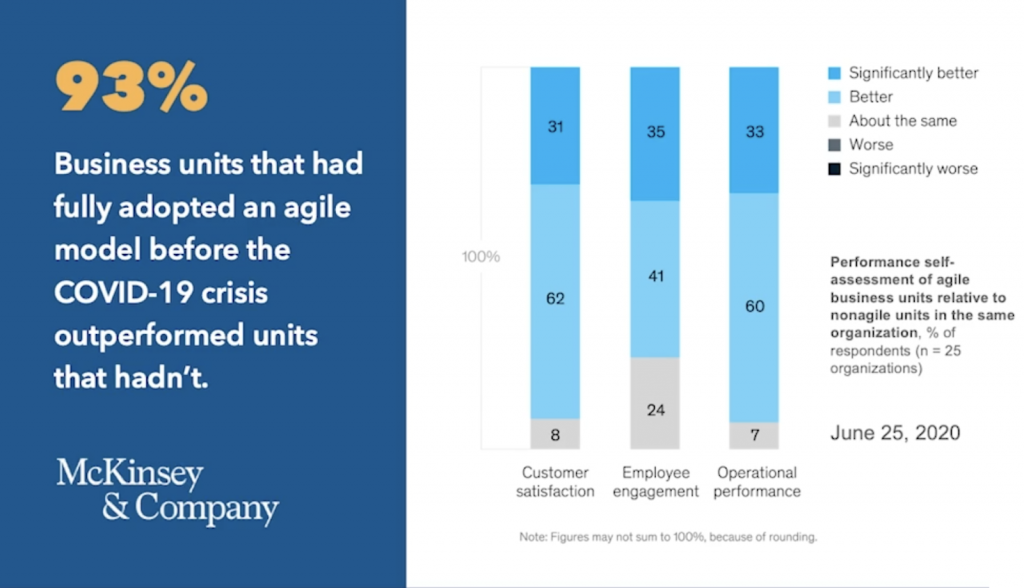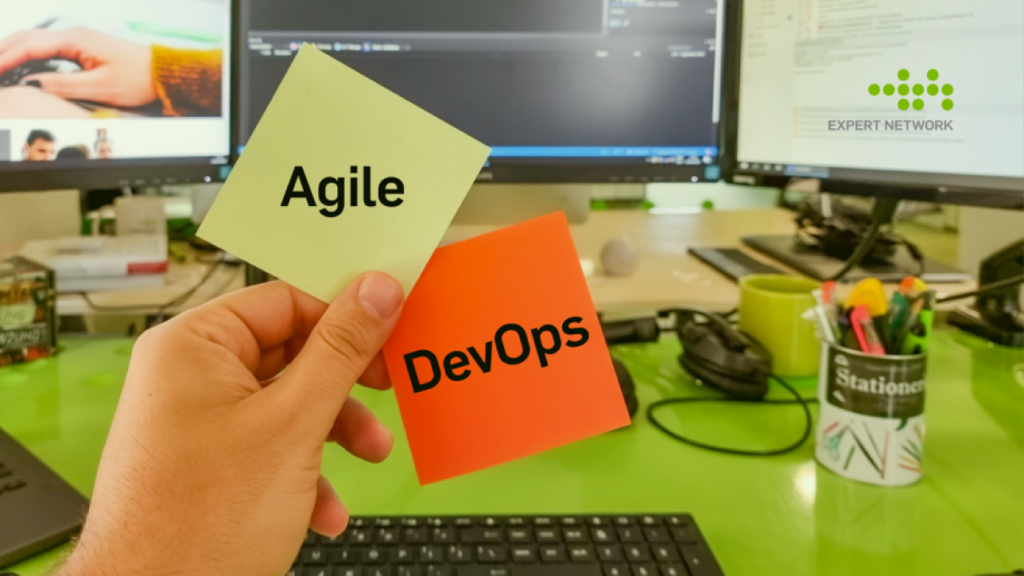As word spreads about the benefits they provide, many organizations are turning to Agile and DevOps methodologies, to really drive organizational outcomes. It’s broadly understood that the goal of Agile and DevOps is to improve and boost the productivity of a business. This is achieved by unifying the people, processes and technologies of development and operations teams in order to develop and deliver high-quality software efficiently, reliably, and cost-effectively.
Beyond the main benefits that have been widely iterated, what else is there to know about Agile and DevOps? In this article, we’ll cover recent statistics about Agile and DevOps, what is required to implement them, and difficulties teams might encounter along the way. We’ll also reveal what inspired our transition and our advice, which is based on our experience, to others who are on the cusp of taking on the challenge.
Take a look at the data
For those still a little unfamiliar with Agile and DevOps, here is a concise analysis of both concepts, their benefits, and what sets them apart. The development of Agile and DevOps has revolutionized the software development industry over the past 30 years. It has replaced traditional and time-consuming methods, with a new culture that promotes progressive and efficient approaches, automation, innovation, as well as improved communication and processes. Data from research into their implementation really exemplifies the value they can bring to those who take on these practices.
The 2020 State of Agile Report reveals that more and more organizations are realizing the value of Agile adoption, with 95% of organizations having adopted some form of Agile process. The 2018 Standish Group Chaos Study results also show that Agile projects are statistically 2X more likely to succeed and 1/3 less likely to fail than waterfall projects. In Chris James’ (CEO Scaled Agile, Inc.) welcome keynote address at the Global SAFe Summit 2020, he shared that 93% of business units that had fully adopted an agile model before the COVID-19 crisis outperformed units that hadn’t.

In a scene where speed, stability, and security are sought-after qualities, Agile and DevOps are the ideal choice to drive improved and elite performance.
What do you need to implement Agile?
Although Agile and DevOps share the common aim of developing and delivering end-products as quickly and efficiently as possible, they employ different approaches and functions.
The Agile methodology is a people-and results-focused approach to software development and testing that is essentially used to create applications. It is centered around adaptive planning, self-organization, and short delivery times. It is flexible, fast, and aims for continuous improvements in quality using techniques like Scrum, Kanban, and eXtreme Programming. The Agile methodology also utilizes certain main tools in its process: Agile boards, backlog management, project and issue tracking, Agile reports, and custom workflows. Some of the best Agile tools to use include ActiveCollab, Agilo for Scrum, Atlassian Jira + Agile, Pivotal Tracker, Prefix, and Retrace.
Although the list for Agile best practices could extend endlessly, here are a few important ones:
- Communicate, whether face-to-face or through open communication tools, at every stage of the project to ensure the process stays on track even as conditions change.
- Work fast, set priorities, and maintain small release cycles. Aim to deploy increments every few weeks and the entire piece of software in a couple of months.
- Integrate fast feedback loops, tracking feedback on the success and speed of the development process regularly.
- Self-organizing teams and employees are empowered, highly motivated, and generate the most value as they understand goals and create their own path to reach them.
- Inspect practices, adjust, and adapt quickly to the process continually.
- Use techniques like pair programming to deliver higher quality.
What do you need to implement DevOps?
DevOps is an evolution of Agile and is fundamentally utilized for application deployment. It brings together the skills, tools and processes from development and operations teams to create a culture all about automation, communication, accountability, increased collaboration and shared responsibility. DevOps standards, practices, and tools are different for every team and every company. As long as the practices and tools adopted help to deliver quality software faster, the goal is served. There is a wide array of DevOps tools available on the market for different categories: GitLab or GitHub for source code control, Ansible or Jenkins for CI/CD management, Kubernetes for container platforms and microservices, Azure or AWS for cloud computing and storage, and so much more.
Here are a few best practices to adopt when transitioning to DevOps:
- Change the culture so that collaboration, transparency, trust, and empathy become a focus. Developers should be involved in operations, and vice versa.
- Have a loosely-coupled architecture at both team level and technology level.
- In addition to source code, version control everything from settings and parameters to software and hardware configuration files.
- Use Agile methodologies for software development and infrastructure to deliver value to customers faster and with fewer headaches.
- Automate everything that can be automated since manual tasks and processes are error-prone and unscalable.
- Shift left with continuous integration, delivery and deployment (CI/CD) pipelines so that if anything fails, there is a fast feedback loop leading to rapid recovery.
- Build with the right tools for each stage of the DevOps lifecycle and use the same tools and platforms in development, staging and production environments so that what works in development will transition successfully to the staging and production systems.
- Continuously monitor the DevOps pipeline and applications so a broken build or failed test doesn’t cause unnecessary delays.
Difficulties along the way to transformation
The transition to Agile and DevOps is hard and an ongoing journey. It’s a real challenge but also delivers real value to organizations. Common issues with Agile and DevOps implementations are a lack of or limited knowledge and Agile skills, legacy infrastructure, and adjusting company culture to adequately support the Agile and DevOps philosophy.
Integrating a new perspective and culture is no easy feat since everyone, including clients, needs to be in agreement and ready to embrace a different approach and new way of working. 75% of major organizational change initiatives fail and the leading cause is a neglect of company culture. Agile and DevOps is all about acceleration and faster releases, and the only way for it to work is to encourage communication, collaboration, and break down silo mentalities. It’s also essential to make the transition accessible, easy to follow, and accompanied by appropriate guidance, support and tools. Fully embracing Agile and DevOps takes open minds, time, practice, and is a continuous job.
Our transformation and advice for others?
A couple of years ago, we began transitioning to Agile and only started integrating DevOps practices later on. Although there was plenty of talk about transitioning to DevOps practices, not everyone on our team was on board with the idea, until a particular book inspired us all. Accelerate: The Science of DevOps by Nicole Forsgren, Jez Humble and Gene Kim motivated us to begin our DevOps transformation. We made use of the practices and capabilities presented in the book to drive high performance in technology delivery and, ultimately, achieve high organizational outcomes.
Besides reading Accelerate: The Science of DevOps, we encourage others who wish to integrate these technologies in businesses and projects, or are on the cusp of a DevOps transformation, to consult research from Google’s DORA team. These reports are informative and will convince others, as well as yourself, on the value that Agile and DevOps practices can provide to your organization. In addition to this, there are several recordings of Nicole Forsgren’s visionary and pragmatic presentations that share insights into the key leadership, technical, architectural, and product capabilities that enable high-performing IT teams to decisively outperform low-performing peers.
The transition to Agile and DevOps is undoubtedly challenging, but they deliver benefits and real value to organizations. With each day that passes, it will get easier to understand and efficiently implement these practices so you can remain innovative and stay on top of your game. As of now, we already enjoy faster releases, CI/CD pipelines, and continuous integration with our Agile and DevOps transformation. We aim to fully achieve continuous delivery and maintain our high performances in technology delivery and organizational outcomes.
